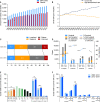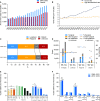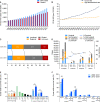Incidence, mortality and survival of gallbladder, extrahepatic bile duct, and pancreatic cancer using Korea central cancer registry database: 1999-2019
- PMID: 35909086
- PMCID: PMC9428428
- DOI: 10.14701/ahbps.22-041
Incidence, mortality and survival of gallbladder, extrahepatic bile duct, and pancreatic cancer using Korea central cancer registry database: 1999-2019
Abstract
Backgrounds/aims: In Korea, pancreatic cancer and "gallbladder and extrahepatic bile duct cancer" were ranked the 8th and 9th most frequent cancers in 2019 and the 4th and 6th most common causes of cancer deaths in 2020, respectively.
Methods: This review provides national cancer statistics and secular trends of 207,521 patients with gallbladder (n = 44,178), extrahepatic bile duct (n = 61,856), and pancreatic cancer (n = 101,487) between 1999 and 2019 in Korea.
Results: The crude incidence rate in both sexes increased in the gallbladder (2.8 to 5.4 per 100,000), extrahepatic bile duct (3.6 to 9.0), and pancreatic cancer (5.5 to 15.8). The age-standardized incidence rate in both sexes significantly increased in the extrahepatic bile duct (3.7 to 4.1) and pancreatic (5.6 to 7.6) cancers but decreased in gallbladder cancer (2.9 to 2.4). The overall 5-year relative survival rate increased in the gallbladder (21.8% to 30.6%), extrahepatic bile duct (23.1% to 27.5%), and pancreatic (8.5% to 13.3%) cancers. Between 2006 and 2019, the proportion of localized or regional stages remained stable. The proportion of surgical treatment within the first 4 months after diagnosis was relatively higher in the gallbladder (42.2%) and extrahepatic bile duct (45.9%) cancers than in pancreatic cancer (22.2%).
Conclusions: The crude incidence and mortality rates of the gallbladder, extrahepatic bile duct, and pancreatic cancer are steadily increasing in Korea, and the prognosis remains poor. Early detection, active application of surgical treatment, and minimization of the proportion of untreated patients are required to improve the survival rates of these cancers.
Keywords: Bile ducts; Epidemiology; Gallbladder; Neoplasms; Pancreas.
Conflict of interest statement
No potential conflict of interest relevant to this article was reported.
Figures



Similar articles
-
Incidence, mortality, and survival of gallbladder, extrahepatic bile duct, and pancreatic cancers in Korea: A population-based study from 1999 to 2022.Ann Hepatobiliary Pancreat Surg. 2025 Aug 31;29(3):209-217. doi: 10.14701/ahbps.25-135. Epub 2025 Jul 28. Ann Hepatobiliary Pancreat Surg. 2025. PMID: 40717397
-
Incidence, Mortality, and Survival Trends in Cancer of the Gallbladder and Extrahepatic Bile Ducts in Lithuania.Medicina (Kaunas). 2023 Mar 27;59(4):660. doi: 10.3390/medicina59040660. Medicina (Kaunas). 2023. PMID: 37109618 Free PMC article.
-
Incidence and Overall Survival of Biliary Tract Cancers in South Korea from 2006 to 2015: Using the National Health Information Database.Gut Liver. 2019 Jan 15;13(1):104-113. doi: 10.5009/gnl18105. Gut Liver. 2019. PMID: 29938462 Free PMC article.
-
[Gender-specific influencing factors on incidence, risk factors and outcome of carcinoma of the liver, gallbladder, extrahepatic bile duct and pancreas].Zentralbl Chir. 2014 Apr;139(2):184-92. doi: 10.1055/s-0034-1368231. Epub 2014 Apr 28. Zentralbl Chir. 2014. PMID: 24777600 Review. German.
-
Double cancer of gallbladder and bile duct associated with anomalous junction of the pancreaticobiliary ductal system.Hepatogastroenterology. 2002 Jan-Feb;49(43):109-12. Hepatogastroenterology. 2002. PMID: 11941931 Review.
Cited by
-
Association Between Hypotension During Pancreatectomy and Development of Postoperative Diabetes.J Clin Endocrinol Metab. 2025 Jan 21;110(2):e249-e256. doi: 10.1210/clinem/dgae227. J Clin Endocrinol Metab. 2025. PMID: 38589985 Free PMC article.
-
Prospective Comparison of [18F]FDG and [18F]AIF-FAPI-74 PET/CT in the Evaluation of Potentially Resectable Pancreatic Ductal Adenocarcinoma.Mol Imaging Biol. 2024 Dec;26(6):1068-1077. doi: 10.1007/s11307-024-01950-w. Epub 2024 Oct 4. Mol Imaging Biol. 2024. PMID: 39365411 Free PMC article.
-
Interpretation, Reporting, Imaging-Based Workups, and Surveillance of Incidentally Detected Gallbladder Polyps and Gallbladder Wall Thickening: 2025 Recommendations From the Korean Society of Abdominal Radiology.Korean J Radiol. 2025 Feb;26(2):102-134. doi: 10.3348/kjr.2024.0914. Korean J Radiol. 2025. PMID: 39898393 Free PMC article. Review.
-
Increased diagnosis of hepato-biliary-pancreatic cancer after cholecystectomy: a population-based study.Sci Rep. 2025 Jan 2;15(1):411. doi: 10.1038/s41598-024-84781-7. Sci Rep. 2025. PMID: 39747399 Free PMC article.
-
Burden and trajectories of biliary tract malignancies in Taiwan from 1998 to 2022.Int J Clin Oncol. 2025 Jul 22. doi: 10.1007/s10147-025-02841-y. Online ahead of print. Int J Clin Oncol. 2025. PMID: 40696064
References
-
- Statistics Korea, author. 236 causes of death, 2020 [Internet] Daejeon: Statistics Korea; 2020. [cited 2022 May 5]. Available from: https://kosis.kr/statHtml/statHtml.do?orgId=101&tblId=DT_1B34E07&vw_cd=M... .
-
- Korea Central Cancer Registry, author. Annual report of cancer statistics in Korea in 2019. National Cancer Center; Goyang: 2021.
-
- Statistics Korea, author. Annual report on the causes of death statistics 2020. Statistics Korea; Daejeon: 2021. - DOI
-
- World Health Organization, author. ICD-10: international statistical classification of diseases and related health problems. 10th rev. World Health Organization; Geneva: 2010.
LinkOut - more resources
Full Text Sources
